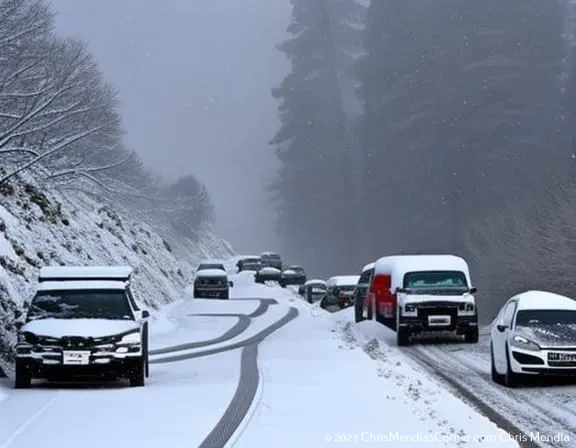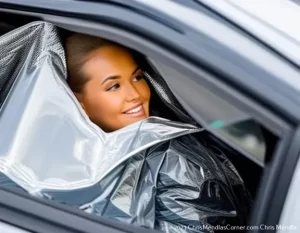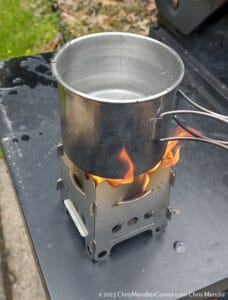Last Updated on 2 years by Christopher G Mendla
Are you prepared for emergencies while travelling? Last year, there was a sudden snowstorm in Maryland. The icy and snowy conditions caused a complete stoppage of traffic. People were stuck in their vehicles for 10 to 24 hours. Preparing a kit for your vehicle could help make the situation tolerable of even save your life.
Why Prepare?
Restricted access roads can mean that you could find yourself in a situation where you can’t exit the highway. You could be stuck in place until the situation is resolved. Things such as weather, accidents, police action, highway failures or even idiot protestors gluing themselves to the highway can bring traffic to a stop. If that happens, you are on your own for a while. Some people refer to these kits as bug out bags.
Take an inventory of risks, environment, personal needs and your skillset.
Each region will have different weather patterns. Keep in mind there can be freak, unexpected storms. If you live in a temperate climate, your needs will differ from someone who lives in areas prone to ice and snowstorms. Accidents can happen anywhere as can protestors blocking roads.
You need to do an assessment of the health and personal needs of the primary driver and likely occupants. Can you survive a night of subzero temperatures without being able to run your engine or if your electric vehicle has a dead battery? Do you have the skills to use a camp stove?
Packaging your kit
I took an approach of distributing things a little. For example, I have one small bag with road flares, blankets and ponchos. It doesn’t take up much room. The silver mylar emergency blankets are a good addition.
I also have a larger sports type bag with pockets inside and outside. The bag has a strap so that I could pack essentials and carry the bag if I had to walk out of the highway for some reason.
I also have things such as denture cream and advil in my console.
Scenario: You get stuck on an interstate due to a sudden ice storm at dusk. Nothing is moving, you were not in an accident. Your best estimate is that you won’t see any help until morning at the earliest. Your immediate needs are warmth and hydration. Do you have what you need in your vehicle?
Medical
If you are dependant on medications, you might consider keeping a 2 day supply in your vehicle. Check with your pharmacist as to the effect of high or low temperatures on the medication. You should also have a trauma level first aid kit with blood clotting bandages and emergency sutures. There are adhesive suture kits that don’t require a needle and sutures. There are also suture kits available. You should have disinfectant and pain killers.
- A trauma level first aid kit with blood clotting bandages, tourniquet, wound closure sutures or bandages as well as pain killers and other first aid.
- If it is possible to pack medications that the driver or passenger might need then they should be either in the kit or on your person. A 2 or 3 day supply would probably suffice for most people. If controlled substances are needed, then make sure they are in a properly labelled bottle.
Kit essentials
There is no one right list for packing. You are limited by the size of your vehicle and available room.
Warmth
If you have a gas, diesel of hybrid, you might not be able to run your engine to provide heat for any number of reasons. When snow is building up around your vehicle, you run a risk of carbon monoxide poisoning. In the case of a full electric vehicle, you are dependent on the battery life. Heating and air conditioning require a substantial amount of power.
- Blankets – Many emergency kits will have a wool blanket. That would be good for one or maybe two people. There are also the mylar blankets that really help retain heat.
- Rain gear – Even a cheap plastic poncho can keep your clothes dry if you have to venture out of the car.
- Hats – A wool pullover hat for each person will go a long way to keeping you warm. A lot of heat can escape from the human head
- Spare clothes – A complete set of spare clothes can be stored in a vacuum bag.
Water
- Having a couple of bottles of water could be a lifesaver. If you keep water in the car be careful of leaving the bottles in high heat as the plastic could leech out. In a situation where you are getting dehydrated, it would be silly in my opinion to not drink the water. Another alternative would be plain seltzer water in cans. Be careful if they are frozen as the seltzer will shoot out when you open it.
- Water filters. You might find yourself in a situation where water is available but you aren’t sure if it is safe. There are any number of water filters available. Pack those using a sealing machine but don’t use the vacuum when sealing so as to not crush them
- Water tablets. There are tablets that you can use to purify water if necessary.
- Instant coffee or tea –
Emergency food.
A person can get very hungry in 24 hours. If you travel through remote areas, some camping meals might be needed. You should rotate your food regularly.
- Nuts – Nuts are filling and provide some protein. Be careful of any passengers with potential allergies.
- Protein bars – Look at the calories on the packages. If you are in a high stress cold situation, you might need 2000 calories per day. Figure out your needs.
- Bullion cube or soup packages – The one problem with these is that they are usually high in sodium.
- Trail mix
- Camping meals. There are camping meals that require added water and those that can be eaten as is.
- Canned soup or stew. This is a possibility if you will not be leaving it in a freezing vehicle. Ideally cans with a pull top instead of cans that require an opener would be best.
Boiling water and cooking
If you are stuck in during low temperatures, a warm cup of tea, coffee or broth can help raise your body temperature and provide some psychological comfort. Small foldable camping stoves can provide a means to heat or boil water. I have two stoves, a very compact stove that can do one cup of coffee in about five minutes and a slightly larger stove with a 4″ x 6″ surface. That could be used for cooking.
Stove choices
Both stoves can use a variety of fuels. I can use a single rutland fire starter square to boil a cup of water using the small stove. Either stove can burn twigs or other fuel. I keep a stainless steel camp cup and two 8 ounce stainless steel tumblers. I also have a camping kit with a stainless pot and pan.
NOTE – Assuming you are in a situation where traffic is stopped. There are a couple of things to consider before firing up your trusty stove and brewing a nice cup of coffee.
- First of all, is there ANY vehicle fuel on the ground. You don’t want to light off your stove and find you just lit up 20 or 30 vehicles. BE CAUTIOUS!!!
- Second, what will be the reaction of other people when you fire up the stove? You could find that someone will come up with a baseball bat with the intention of making your stove their stove.
Other motorists will probably not have water, cups or fuel. If you are not in the midst of people, then you will not have to worry about people. You might have to worry about wildlife such as a hungry, fat bear who is attracted for some reason to your bullion cubes.
Test drive your stove
Try assembling the stoves before you actually need them. The larger stove is easy to assemble. The smaller stove is a lot more difficult. It is made of very thin stainless steel. I put that stove in a box fully assembled. That way, if I need it, I don’t need to fidget with it.
- A foldable camp stove
- Metal cups (preferably stainless steel) – A metal cup can be heated directly on the camp stove. Keep in mind that if you heat the steel cup it will be hot.
- A camping pan and pot kit – These fold up and include a small pan and a pot with a lid.
- Silverware. You don’t really need a camping kit. Some spare knives, forks and spoons will do.
- Can openers. Both the church key type and the type to open soup cans.
Light
Today’s LED flashlights are a huge advance over the battery eating incandescent flashlights used previously. You can find flashlights that are USB rechargeable. Many of these can also be used to charge small devices such as phones.
Keep in mind that many of today’s new cars will not power their USB ports or socket if they are not running. Be sure to have a regular schedule to keep your flashlights and batteries charged.
Being stuck in your vehicle overnight in a storm could be less stressful if you have some light.
- One or more small LED Flashlights
- Batteries or a means to recharge them.
Fire making/fuel gathering
I keep a decent axe in my kit. It’s not something I would want to use every day. However if you find yourself in a survival situation, it could be handy for gathering firewood. A small pruning saw could also be useful.
Cars today don’t seem to come with cigar lighters. The small survival knife I have contains a fire starter. I also packed two small butane lighters in a sealed bag. Again, seal the lighters but don’t use the vacuum.
- A small sharp camp axe and small saw to gather firewood. If you are unfamiliar with using an axe or hatchet, you might want to practice with it. Many people become careless due to the small size of the axe.
- Fire starters. I like the Rutland fire starters. I use them in my wood stove. They are relatively easy to light and burn clean and well. The are easy to seal with a food sealer.
- One or more lighters or fire starters
Communications
In today’s age of cellphones, it is easy to overlook the fact that there are other communications devices available such as walkie talkies. A pair of walkie talkies could be handy if someone needs to leave the car for some reason. Keep in mind that there are limits to their range and also that you will need batteries or a way of charging them.
- Two or more walkie talkies with spare batteries or a means to recharge them.
Other items
The following are suggestions of things you could pack. You will need to optimize the kit for your specific needs
- A survival type knife. This can be a small folding version. It should hold a good edge and be sturdy.
- Rope or cord. Some axes are sold wrapped in paracord. I would rather have any cord separate from something like an axe.
- A compass and a basic understanding of how to use one. With the prevalence of GPS I believe that a lot of people would have no idea how to use a compass.
- A signalling mirror if you are going off road.
- A battery powered carbon monoxide alarm. If you are stuck in a winter storm and are running your vehicle to keep warm, be aware of the danger of carbon monoxide poisoning.
- Cash – You can put perhaps 20 to 100 dollars in your bag in small bills for emergencies. Something like major power outages could cause card processing systems to be down.
Summary
You need to design a kit to meet your specific needs.




